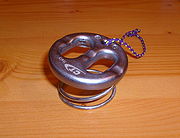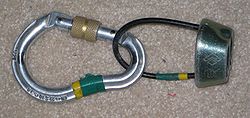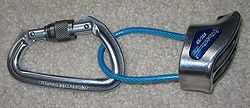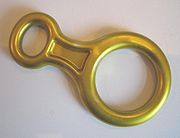
Belay device
Encyclopedia

Belaying
thumb|200px|right|A belayer is belaying behind a lead climberBelaying refers to a variety of techniques used in climbing to exert friction on a climbing rope so that a falling climber does not fall very far...
. They are designed to improve belay safety for the climber by allowing the belayer to manage their duties with minimal physical effort. With the right belay device, a small, weak climber can easily arrest the fall of a much heavier partner. Belay devices act as a friction brake, so that when a climber falls with any slack in the rope, the fall is brought to a stop.
Belay devices generally have two modes of operation: in the first mode, the rope is relatively free to be paid in/out by the belayer. The second mode, which allows the belayer to arrest the descent of a climber in the case of a fall, functions by forcing the rope(s) into tight bends where the rope rubs against the belay device and/or against itself. This rubbing slows the rope, but also generates heat. Some types of belay devices can transition between these modes without the belayer taking any action, others require the belayer to hold or pull the rope in a particular direction to arrest a fall.
Belay devices usually attach to the harness of the belayer via a carabiner
Carabiner
A carabiner or karabiner is a metal loop with a sprung or screwed gate that is used to quickly and reversibly connect components in safety-critical systems. The word comes from "Karabinerhaken", meaning "hook for a carbine" in German.-Use:...
, and are usually made of aluminium or an alloy.
Some belay devices can also be used as descenders for a controlled descent on a rope, that is abseiling or rappeling.
Many belay devices can be used to control either one rope, or two ropes in parallel. There are many reasons why the two-rope option might be chosen by a climber, including the consideration of reducing rope drag
Rope drag
In rock climbing, rope drag is the friction of the rope plus its weight that the climber feels when pulling a rope through a number of protection points, or over rock prominences...
.
Aperture
This is a device that you feed a bightBight (knot)
In knot tying, a bight is a curved section, slack part, or loop between the two ends of a rope, string, or yarn. The term is also used in a more specific way when describing Turk's head knots, indicating how many repetitions of braiding are made in the circuit of a given knot.-Slipped knot:In order...
(loop) of rope through a hole or Aperture
Aperture
In optics, an aperture is a hole or an opening through which light travels. More specifically, the aperture of an optical system is the opening that determines the cone angle of a bundle of rays that come to a focus in the image plane. The aperture determines how collimated the admitted rays are,...
and then hook it into a locking carabiner on the harness.
Sticht plate

Nowadays, Sticht plates are becoming less popular since more modern designs provide smoother control over the rope and are less prone to jamming, especially when doubling as a descender.
Tubular devices
This type of device generally has a tubular or rectangular shape. It is an evolution of the Sticht plate's concept by creating more surface area to dissipate heat and the ability to create sharper angles which creates a stronger degree of friction which has greater stopping power. As a result this is generally the most common type of belay device used. This type of device goes by multiple trade names including Black Diamond ATC (Air Traffic Controller), DMM Bug, Trango Pyramid.Besides arresting the fall of a climber, these devices can also be used for rappelling.
 |
 |
Figure eight

Self-Locking
Referred to as self-locking or autolocking these devices automatically restrict the rope from being pulled away from the device by pressure applied by a climber. This is achieved as either a default setting or as an electable mode of the device.Guide Plate
This is a metal plate with an elongated slot for the bight to go through and then a carabiner is attached so that when pull from the climber occurs the carabiner will be pulled to lock off the device.Tubular Device Variant

A similar device to the traditional tubular belay device has an extra loop as a part of it so that you can attach the device to an anchor and use a second carabiner to perform a similar stopping function to that created with the guide plate. This is meant to when not using the second carabiner implementation this can be used just like a normal tubular device. This device goes by two trade names the Petzl Reverso and the Black Diamond ATC-Guide. This and the Guide plate are considered safer alternatives to using the Italian Hitch (a.k.a. Munter hitch
Munter hitch
The Munter hitch, also known as the Italian hitch, is a simple knot, commonly used by climbers and cavers as part of a life-lining or belay system. To climbers, this knot is also known as HMS, the abbreviation for the German term Halbmastwurfsicherung, meaning half clove hitch belay...
).
Gri-Gri
.jpg)
A Gri-gri is a belay device that automatically locks the rope in the event of a fall. Because of the self-locking mechanism, modified belay techniques are widely used. Gri-gri's reportedly give a harder catch than a regular belay device because they allow less rope slippage when catching a hard fall. They are a proprietary design by Petzl. The Gri-gri is a preferred device for belaying the follower directly off the anchor because lowering the follower is quite easy. Trango sells a similar self-locking belay device called the Cinch that is rated to work on ropes 9.4 to 11 mm (the Gri-Gri is rated from 10 to 11 mm).
Using a Gri-gri to bring up a second on a traditional anchor is however less favorable than other belay devices because the Gri-gri gives a more static catch with little to no rope slippage. This increases the amount of force exerted on the anchor which, in turn, increases the chance of anchor failure.
Self-belay devices

Solo climbing
Solo climbing or soloing is a style of climbing in which the climber climbs alone, without somebody belaying him. There are three ways to climb solo:* Roped solo climbing:**lead climbing with a self-locking device which is used to arrest a fall...
where the climber wears the belay device, or secures it to a fixed object on the ground. These devices automatically lock without any intervention when placed under sufficient load (during a fall), but allow rope to move relatively freely whilst climbing.
See also
- BelayingBelayingthumb|200px|right|A belayer is belaying behind a lead climberBelaying refers to a variety of techniques used in climbing to exert friction on a climbing rope so that a falling climber does not fall very far...
- ClimbingClimbingClimbing is the activity of using one's hands and feet to ascend a steep object. It is done both for recreation and professionally, as part of activities such as maintenance of a structure, or military operations.Climbing activities include:* Bouldering: Ascending boulders or small...
- Climbing EquipmentClimbing equipmentA wide range of equipment is used during rock climbing. The most popular types of climbing equipment are briefly described in this article. The article on protecting a climb describes equipment commonly used to protect a climber against the consequences of a fall....
- Capstan equationCapstan equationThe capstan equation or belt friction equation, also known as Eytelwein's formula, relates the hold-force to the load-force if a flexible line is wound around a cylinder ....

